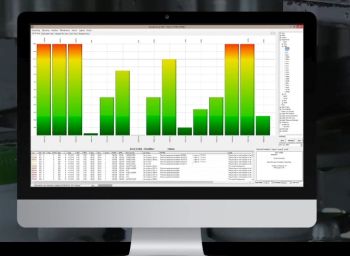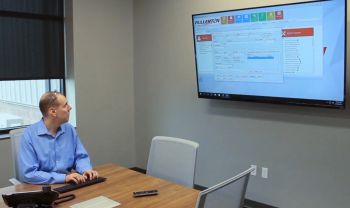10 Ways ERP Enables On-Time Delivery -- Every Time
ERP transforms the scheduling process by tracking everything that happens on the plant floor. It then combines the data with information you input through work orders, routers, BOMs, etc. to create the most efficient schedule. Here are 10 ways it helps accomplish the result every manufacturer wants -- on time delivery every time.

Know the status of jobs in real time.
One of the biggest advantages of ERP scheduling is the ability to track jobs in real time. With a few key strokes, you can easily see the current status of any job, including where it's been, where it is now, and where it's going next. You can also see whether it's on schedule or lagging behind. Having access to this data helps identify bottlenecks while jobs are in progress to ensure they get completed on time.
Know your true capacity for machines, workcenters and personnel.
When you can't determine the true capacity of resources and people, you can only guess.
With ERP scheduling, the system automatically does the scheduling for you, in minutes rather than hours, with maximum efficiency and full capacity utilization. Planners get a real-time overview of all workcenters and available labor hours, allowing them to balance loads across resources by instantly identifying which ones have excess load or capacity.
Easily move or reroute jobs for better forecasting.
When rerouting jobs, the inability to see how the changes will impact other jobs makes it difficult to adjust your schedule on the fly. It can also lead to accepting customer due dates hoping (rather than knowing) you can make them.

ERP scheduling makes rerouting jobs simple with short- and long-term "what if" scenario planning. Simply insert a current or new job where it needs to go and the system automatically adjusts the schedule forward, backward or globally. Seeing how job changes will affect the entire schedule improves forecasting and minimizes hot and past-due jobs.
Identify production bottlenecks in real time.
Manual scheduling creates bottlenecks when multiple jobs get stacked on top of each other due to limited capacity. ERP reduces, and in many cases, eliminates these bottlenecks by automatically scheduling the right job on the right machine at the right time. It also identifies when and where the workflow will be light or heavy, allowing planners to adjust labor hours and move people around to balance the workloads.
Instantly see how new or "hot" jobs will affect other jobs.
How many times have you pulled an ongoing job out of a machine to respond to a more urgent order, knowing you will lose money on the job? Many companies try to solve this problem by hiring more schedulers, which only adds to the complexity of the scheduling process. With ERP, you can insert a hot job and instantly see how it will impact current and future jobs on the schedule.
ERP provides this scheduling picture by gathering data on workloads, available capacity, workcenter and employee constraints, setup and run times, and more. It then calculates the changes to jobs on the schedule with precision. Planners can finitely or infinitely schedule, balance work center loads, engage in advanced labor scheduling, and immediately see the results.
Accept customer due date requirements based on factual data.
With manual scheduling, setting due dates often relies on guesswork. ERP tracks what you're making, how you're making it, how many you're making, and work in progress at any given moment. It uses this data to determine exactly when each job will be finished so you can confidently tell customers when they will receive their parts.
Salespeople will have confidence when promising due dates.
From a sales perspective, one of the real strengths of ERP scheduling is the ability to turn a "no" into a "yes we can" when customers request difficult due dates. It does this by providing complete visibility of data on every job -- from work order number to completion due date -- in a variety of formats.

Before accepting a due date, salespeople can quickly determine inventory levels, available workcenter and labor hours, current status of jobs in progress, and other variables that impact production. If the customer's requested due data isn't available, planners can perform forward and backward scheduling to see if jobs can be moved around to accommodate the date. Either way, the decision is based on reliable data so sales reps can promise a due date with confidence rather than hoping production will get the job done on time.
Production managers have more time to manage.
With manual scheduling, production managers often spend inordinate amounts of time trying to fix the schedule. ERP allows them to do the job they were hired to do -- respond to and manage events on the plant floor that require their knowledge, expertise and judgment.
Lower production costs.
The ability to schedule quickly and accurately lays the foundation for a host of shop floor benefits, including lowering the cost of setup, production, shipping, and more. For example, when customers order the same part with different due dates, ERP reduces setup time by scheduling multiple jobs of the same part to run concurrently rather than days or weeks apart.

The ability to see your true machine and labor capacity allows planners to avoid unnecessary overtime. Knowing exactly how long each step of a job takes reduces indirect labor because machinists know what to work on next and when to expect it.
Sleep better at night.
The uncertainty that comes with manual scheduling creates tremendous stress. ERP software takes the stress out of scheduling by simplifying and automating the entire process. ERP software enables companies to achieve faster cycle times, better on-time delivery rates, reduced administrative overhead, lower labor and materials costs, improved productivity, and more. You'll sleep better knowing your scheduling and your business are in good hands.
Want more information? Click below.
Rate this article
View our terms of use and privacy policy ::m::